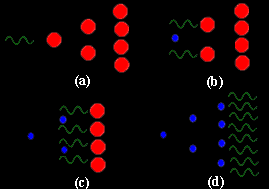What is a MASER?
MASER stands for Microwave Amplification by Stimulation Emission of Radiation. A LASER is a MASER that works with higher frequency photons in the ultraviolet or visible light spectrum (photons are bundles of electromagnetic energy commonly thought of as "rays of light" which travel in oscillating waves of various wavelengths) .
The first papers about the MASER were published in 1954 as a result of investigations carried out simultaneously and independently by Charles Townes and co-workers at Columbia University in New York and by Dr. Basov and Dr. Prochorov at the Lebedev Institute in Moscow. All three of these gentlemen received the Nobel Prize in 1964 for their contributions to science.
[The following was paraphrased in part from Halliday & Resnick's "Fundamentals of Physics", second edition.]
The fundamental physical principle motivating the MASER is the concept of stimulated emission, first introduced by Einstein in 1917. Before defining it we look at two related but more familiar phenomena involving the interplay between matter and radiation, absorption and spontaneous emission.
Absorption. According to quantum mechanics, absorption of photons by atoms occurs only if the wavelength of the photon is just the right size (say, of wavelength l). If it is, the atom will "absorb" it (the photon vanishes) and go to a higher energy state. In physics, this process is called "absorption."
Spontaneous Emission. Atoms don't like to stay in high energy states (this is dictated by the laws of thermodynamics), so after absorbing a photon and going to a higher energy state, they will move of their own accord to a lower energy state, emitting a photon in the process. This is called "spontaneous emission" because no outside influence triggers the emission. Normally the average lifetime for spontaneous emissions by excited atoms is around 10-8 seconds (that is, the atom or molecule will usually take around 10-8 seconds before emitting the photon). Occasionally, however, there are states for which the lifetime is much longer, perhaps around 10-3 seconds. These states are called metastable. Metastable emission levels are essential for a working MASER and will be discussed further in a moment.
Now that we've discussed absorption and spontaneous emission, we can get to stimulated emission (a MASER beam is made up entirely of stimulated emission).
 Stimulated Emission. With stimulated emission, a photon of the absorption
wavelength, l , is fired at an atom already in its high energy state from prior absorption.
The atom absorbs this photon, and then quickly emits two photons to get back to its
lower energy state. Thanks to quantum mechanics, both of these newly emitted photons are of
wavelength l! The following figure displays this concept
in detail:
Stimulated Emission. With stimulated emission, a photon of the absorption
wavelength, l , is fired at an atom already in its high energy state from prior absorption.
The atom absorbs this photon, and then quickly emits two photons to get back to its
lower energy state. Thanks to quantum mechanics, both of these newly emitted photons are of
wavelength l! The following figure displays this concept
in detail:
MASER. In each frame, a molecule in the upper level of the MASER transition (that is, in the high energy, excited state) is indicated by a large red circle, while one in the lower level (low energy state) is indicated by a small blue circle. (a) All of the molecules are in the upper state and a photon of wavelength l (shown in green) is incident from the left. (b) The photon l stimulates emission from the first molecule, so there are now two photons of wavelength l, in phase. (c) These photons stimulate emission from the next two molecules, resulting in four photons of wavelength l. (d) The process continues with another doubling of the number of photons.
[Figure courtesy M. L. Kutner, "Astronomy: A Physical Perspective", John Wiley & Sons, Inc. 1987]
Basically, a man-made MASER is a device that sets up a series of atoms or molecules and excites them to generate the chain reaction, or amplification, of photons. Metastable emission states make MASERs and LASERs possible. To get the proper wavelengths to generate the chain reaction, first electricity or another energy source is "pumped" into a chamber filled with particular atoms or molecules. Then this "pumping" radiation causes the transition of atoms from the ground state to a high energy excited state higher than that referred to in the above paragraphs. From this short-lived state the atoms come down through non-radiative transition to the long-lived metastable state. Once in the metastable state many atoms can be accumulated in one place and in the same state. The LASER or MASER beam, stimulated emission, arises when all these accumulated atoms simultaneously make a transition to the ground state, releasing their energy of wavelength l, creating a beam of microwave radiation (or visible light in the case of a LASER) which can be sent on to other atoms to cause the chain reaction described in the above figure. Since all the resulting photons are the same wavelength, MASER beams are extremely focussed and coherent. MASERs and their shorter-wavelength counterparts (LASERs), have many practical applications, especially in science and medicine.
Naturally occurring MASERs have been discovered in interstellar space. For more information about MASERs in space, check out this site for a discussion of astrophysical MASERs.
